Interview
Juana Estrada Hernandez: Into the Wild
Photo credit: Argenis Apolinario
“Into the Wild” is a regular interview with early career print artists. Interviews will highlight the varied paths the subjects are taking to strike an accord between life and their artistic practice. Expect a balance of approaches, from those hopping the residency circuit, to those teaching part-time or who snagged the elusive tenure-track gig right out of the gate, or those working a desk job or waiting tables to afford access to a community print shop or maker space. In short, there’s many ways to “make it” and we want to share them all!
Have an idea for a person to interview? Please submit suggestions to the Interviews section of the Submissions portal below.
Juana Estrada Hernandez, MFA
Juana Estrada Hernández is a Mexican artist and Assistant Professor of Printmaking at the Rhode Island School of Design. She received her MFA in Printmaking from the University of New Mexico and her BFA in Printmaking from Fort Hays State University. Estrada Hernández has exhibited her work across the United States, Mexico, Canada, the United Kingdom, and Poland. She has appeared in multiple publications including Migratory Yellow Pages, Hyperallergic Magazine, Printmaking Today, and on the Hello Print Friend podcast. Her work is held in several collections including those of the Janet Turner Print Museum, Chicago Printmakers Collaborative, Zygote Press Archives, Laval University, and Engramme, National Library and Archives of Québec.
Artist Statement:
My artwork centers on socio-political issues related to immigration, particularly for communities affected by Deferred Action for Childhood Arrivals—a United States immigration policy that provides administrative relief from deportation and work permits for some immigrants who arrived as minors without legal resident status. As an individual who emigrated to the United States from another country, I was forced to assimilate to a new culture to survive and thrive. Within my work, I highlight the importance of holding on to one’s own culture as a method of resistance, pride, and celebration. My work is visually informed by my love of drawing, my family’s intergenerational migration stories, cultural traditions, foods, and language. It interrogates the false promises, limitations, and contradictions of the ‘American Dream.’ As a DACA-mented artist, I accept the responsibility to use my work and voice to advocate for and expose my audience to social-political issues that impact my community.
I primarily work in traditional prints, but as of late I have begun a series of sculptures as an extension of my artwork. I am interested in finding engaging ways to create artwork that continue to push the boundaries of printmaking. I grew up landscaping with my dad and building things. Sculpture seems like a natural extension, and I am excited to see how it unfolds. I am also interested in creating illustrations in children’s books as a continuation of my drawing practice.
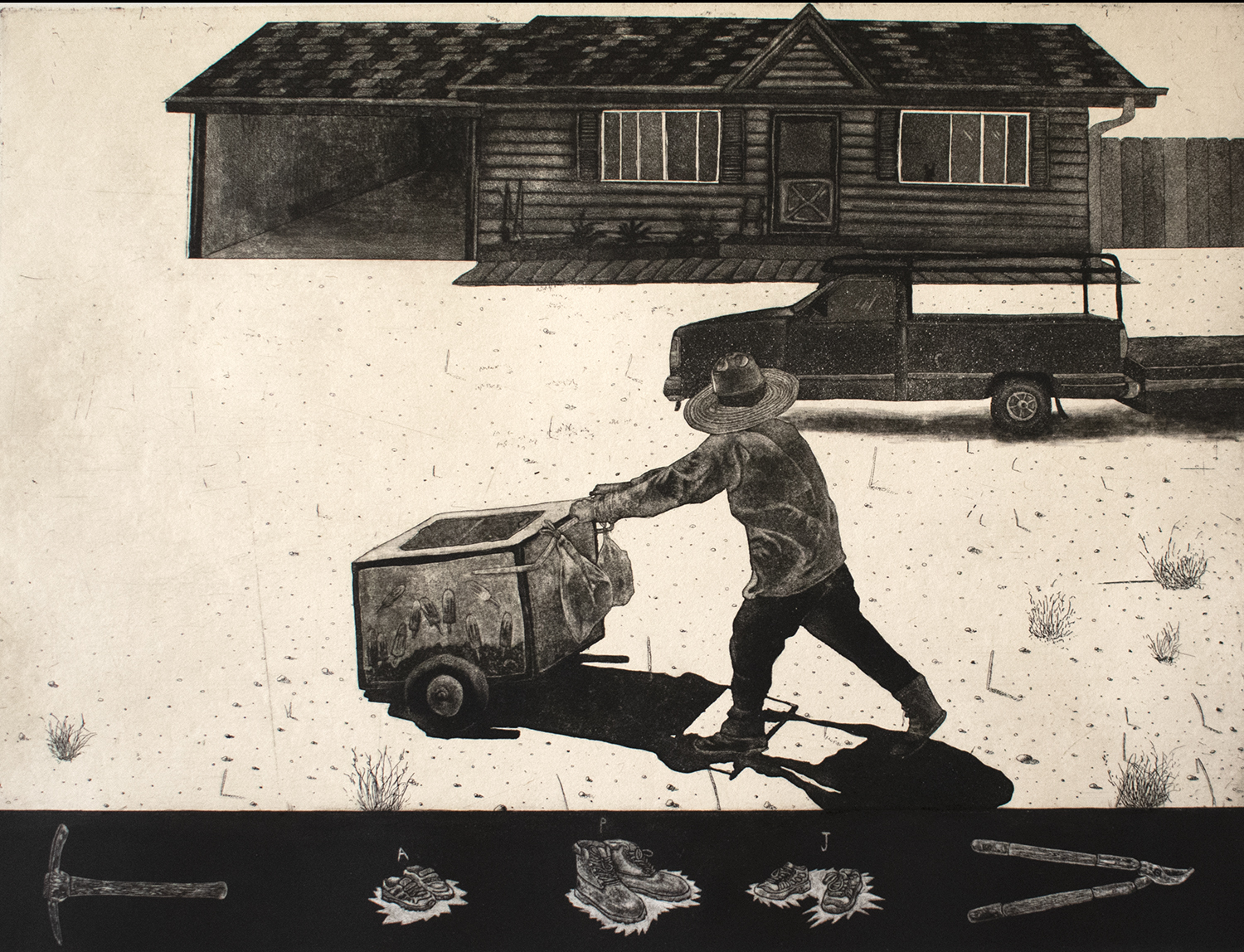
Ah Chambiar para nuestra Casita
Etching, Mezzotint; 18″ x 24″; 2021
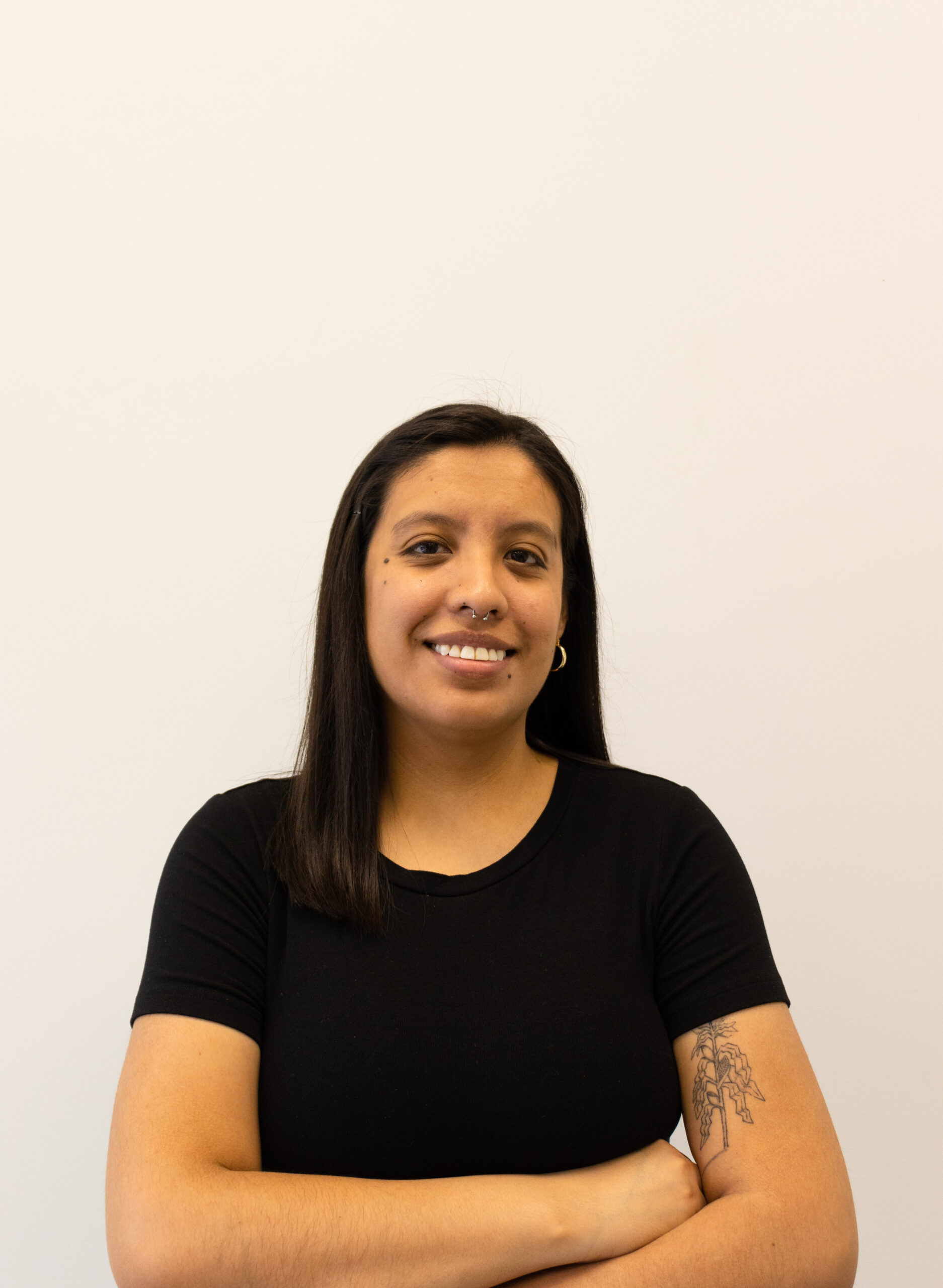
Juana Estrada Hernandez
Photo credit: Caity Frazer
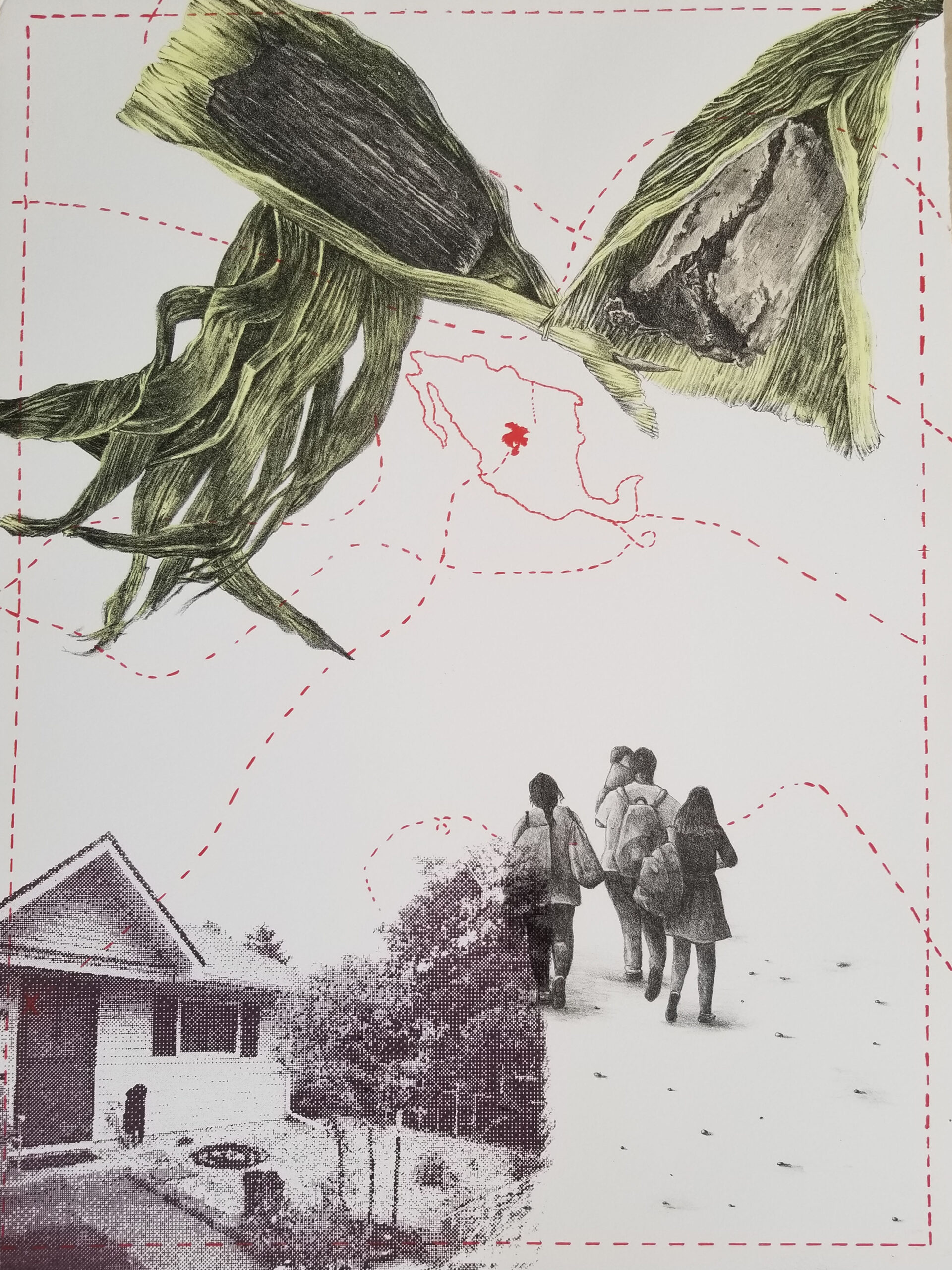
Comida de mi Madre
Lithograph, screenprint; 20″ x 15″; 2021
The Interview
Blake Sanders: Please share about your education. What brought you to Fort Hays, then to UNM for your masters? How did your experience in Albuquerque contribute to your development as an artist?
Juana Estrada Hernandez:
My educational journey was unique in the sense that I pursued my education by chance and taking up opportunities as they came. I grew up in Denver, graduating from high school and community college. Once it came time to pursue my BFA, it became difficult to apply for colleges and get full ride scholarships because of my DACA status. I ultimately heard from a few friends in high school that a college in Hays, KS was providing substantial financial assistance to students of color and undocumented students. Hector Villanueva was the recruiter at the time that helped me get to Fort Hays State University and pursue a path in the Arts. I always dreamed of going to UC Boulder, MSU Denver, RAMCAD, RISD, or any of those schools that had great art programs. However, the universe had something destined for me and at the time I couldn’t see it.
When I was in my final year of the BFA Printmaking program, my teacher Gordon Sherman asked me “What do you want to do after school”. I told him that I wanted to be a printmaking teacher of some capacity and continue finding ways to make artwork. He told me “Okay, you are going to graduate school.” I remember thinking to myself, “what is that?”. There is no way that I will be able to get into any masters programs. I am a first generation student and the thought of jumping into another program seemed impossible. I had no path to follow, so I continued trying to make my own.
When I was searching for a graduate school to attend I looked for a variety of things. Did that university offer a range of techniques that I had not learned before? Did they have a large creative community in the area? What kind of funding did they offer? Did they offer teaching opportunities? Could I afford to pay for the application? Would my partner and I be able to go together? I applied to eight graduate schools and I was accepted to all of them. However, funding played an important role in ultimately choosing a program. That was due to the fact that as a DACAmented student we aren’t allowed to apply to any federally funded loans or programs like FAFSA. I needed to ensure that I would be able to start and finish the program. I also attended my undergraduate program in Kansas and I realized that I wanted to be in a larger city, art scene, and student diversity. I was truly inspired and excited to be in a community that had people living from all over the world in one place. Seeing street signs written in Spanish felt familial and comforting. Once I ultimately moved to Albuquerque, everything felt “right”. The southwest region gave me a sense of home and I believe that it had to do with the fact that I was geographically closer to Mexico, the New Mexican food, and culture.
I knew that Takach press, Tamarind, Remarque were all in the same city as well as the various studios in Santa Fe. Yet, at the time I truly didn’t realize how resourceful, and amazing that was. I was just happy to continue my education and keep making prints.
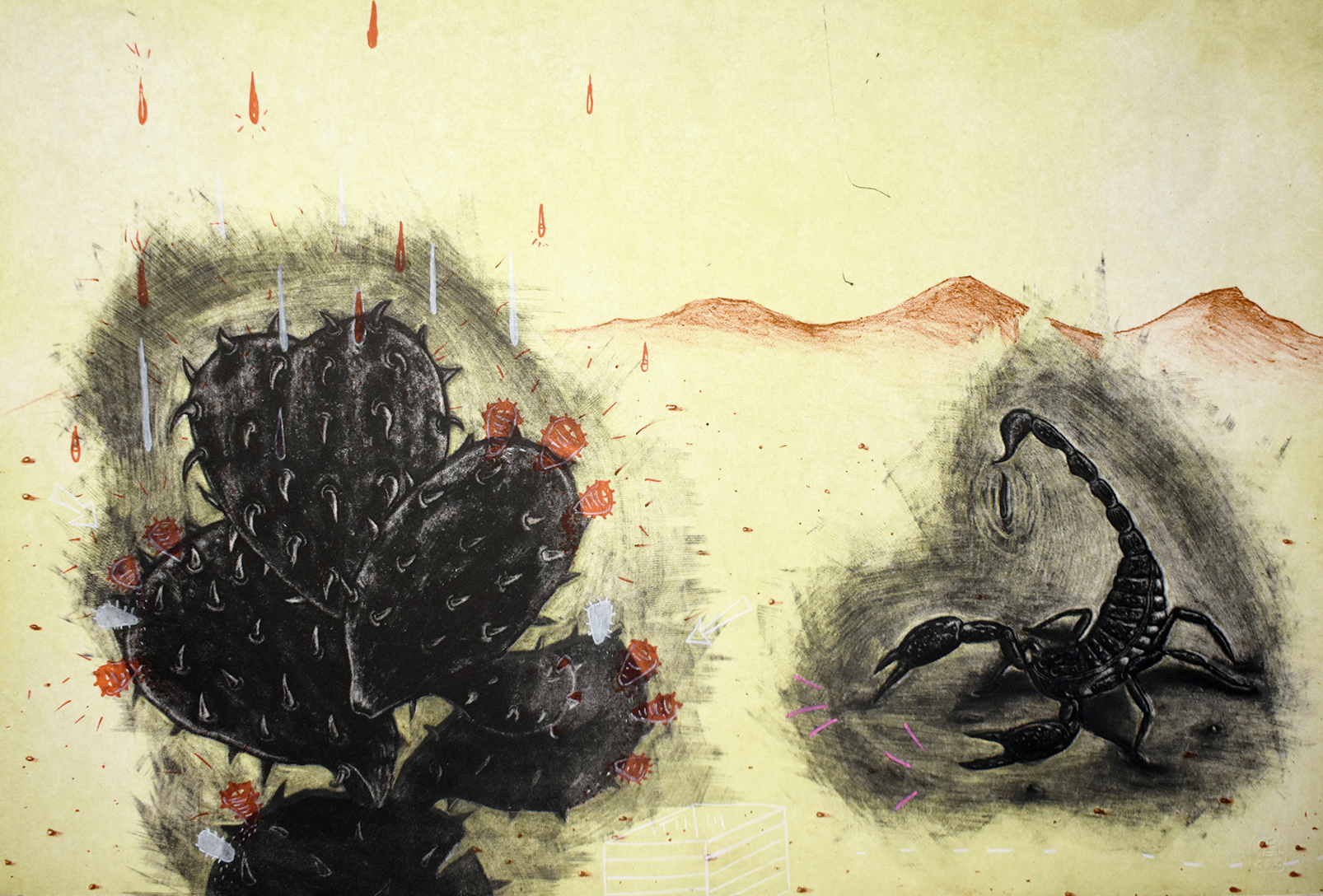
As Far as the Eye Can See
Mezzotint, lithograph; 12″ x 18″; 2022
B: After graduate school you returned to Fort Hays State University to teach printmaking before earning your new position at RISD. What was it like to return to your undergraduate institution to teach as a celebrated young print artist? What do you anticipate the move will be like from the familiar at Fort Hays to Providence?
JEH: Returning to FHSU was interesting because I did not think that I would get that position. In the sense that I was fresh out of graduate school and I wasn’t sure I was qualified enough. During the summer of 2021, I was getting ready to start my Thesis semester in the fall when I got the call. So I started my new job and my thesis semester at the same time.
I was nervous about the transition with the students, would I be able to balance finishing my thesis work and teaching full time? In some ways it was easy to return because I had already lived in Hays, I knew some of the professors, some of my undergraduate friends had stayed for graduate school at Fort Hays. Yet, everything was radically different. There was a new building, new faculty, and I was the new assistant professor of Printmaking. I had a support net with the faculty at FHSU, and I was looked at as a leader of my area. It was an incredible opportunity to start my teaching career in this way. I look forward to moving to the East coast. The geography, culture, food, and educational landscape will be different. It will all be new and it makes my stomach flip. It is incredible that it is happening.
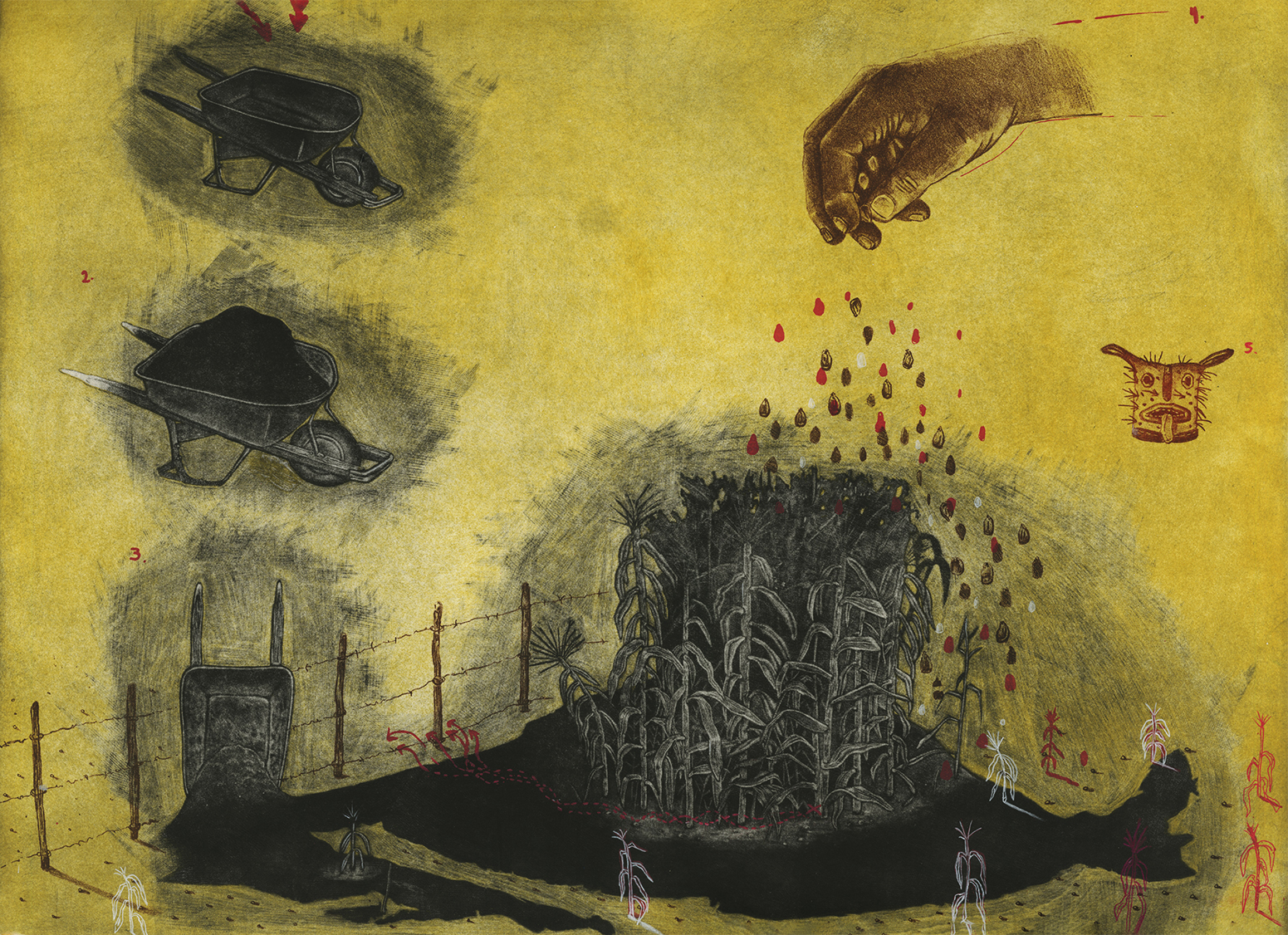
It Began With Us
Mezzotint, lithograph, screenprint; 18″ x 24″; 2021
B: Spring semester is your first term teaching at RISD. How have you used the fall semester to nurture your career and work, and transition into your new position?
JEH: I am using my fall semester to rest when I can, make art, go on dog walks and be with family. I had already committed to various artistic commitments before the acceptance of my new job so it’s been nice to be able to fully commit to that before my big move. I will be attending my first international residency in Australia. I was invited to Megalo Print Studio to create new work. I am interested to see how my work will change and my perspective being outside the United States.

Lo Queno lo Sensenan Parte Dos
Monotypes, paper gallons, woodcut; 9′ x 5′; 2019
B: Please tell us a bit about your work. How has making your artwork changed since you left school?
JEH: My artwork centers on sociopolitical issues related to immigration, particularly for communities affected by Deferred Action for Childhood Arrivals—a United States immigration policy that provides administrative relief from deportation and work permits for some immigrants who arrived as minors without legal resident status. As an individual that emigrated from another country, I was forced to assimilate to a new culture to survive and thrive. My work pays homage to my Mexican culture, drawing on visual references from Mexican traditions, foods, and language. Within my artwork, I highlight the importance of holding on to one’s own culture as a method of resistance, pride, and celebration. My artwork is visually informed by my love of drawing as I explore immigration and identity issues through references to Mexican Pop-Culture, and my family’s inter-generational migration stories.
My current studio practice is a fine balance between a full-time teaching job and making art in the afternoons when I can. My practice is rooted in creating drawings that will eventually be re-interpreted through printmaking processes. I try to maintain a daily sketchbook practice that is a combination of writings, drawings, color swatches, and material tests. My home studio for the past two years consisted of a drafting table, a hand-built tall table with a plexiglass top, a foldable 6ft table and small etching press. When I began my first teaching job at Fort Hays, I had to learn that being a full time faculty and trying to be a full time artist was not going to work. Once I finished my MFA program during my first semester of teaching I realized that I needed to prioritize my studio time in a way that was sustainable for my health.
I used my home studio to prepare drawings, pre-mix inks, and tear paper. I sometimes would print at home but I started working bigger and needed the equipment at the university. When I wasn’t teaching I would come into the university printmaking studio and print early mornings or late evenings on Friday, Saturday and Sunday. My students would sometimes bring me dinner because they knew that I would be working late into the night. It was interesting because there were no more due dates, major examinations anymore. It gave me the time to truly discover what I needed to do to continue to develop myself as an artist. My expectation of how much work I could produce also had to change because of the lack of time. I also wanted to make sure that I could teach as well as I could and be there for my students, clear minded. I typically spent about 25 hours a week on my artwork when I was full time teaching. When I am not teaching it can sometimes be 40 hours a week. This time can be split between researching, drawing, taking a trip to see art, preparing materials, administrative work, etc.
In the past year I have been invited as a visiting artist and this has given me the opportunity to visit other print shops, meet new artists/ faculty, and create new printed editions. This has been really fun because every time I visited somewhere new I brought back a new skill, organization idea, or found ways to make my studio at home or the school better.
In terms of content, I have continued the series of works that I created for my thesis work. However, my work has visually become more colorful and celebratory. My sense of urgency to create artwork that highlights my Mexican culture in positive ways, nuanced upbringing in the U.S. as an undocumented youth, and about the social/political landscape of immigration policies affecting Latinx communities is more important than ever. Representation is important in all aspects of society because it can create bridges for understanding and positive change.
Some trials and tribulations that I have experienced navigating my career are primarily due to uncontrollable circumstances of policy change. I have had DACA for the last ten years and living with uncertainty is exhausting. I pursued my graduate studies immediately after my undergraduate program in 2018 because the Trump Administration had promised to remove the DACA program. In my second year of graduate school, 2020, the Supreme Court ruled 5-4 that the Trump administration improperly ended DACA, allowing it to stay in place. And currently, it is being litigated again and the decision landed on a judge in Texas. Judge Hanen ruled against DACA yet again and doubled down on his decision to halt new applications. DACA recipients are, once again, in a state of limbo, and it’s exhausting. That’s not even to mention the millions of immigrant youth who would have been eligible for DACA, but can no longer apply. This back and forth is truly terrifying at times but we have to keep finding ways of moving forward.
Some of the successes have been able to work with larger organizations like United We Dream in their creative projects. United We Dream is the largest immigrant youth-led network in the country. The group was involved in advocacy surrounding the passing of the Deferred Action for Childhood Arrivals bill. I contributed to their second Zine issue which provided the opportunity for writers and artists to share their work and joyful resistance.
I am filled with gratitude at the opportunities that I have had as an artist and the community of people that have supported my journey. I used to believe that this artistic life was not granted to people that came from backgrounds like mine or people who looked like me. I don’t believe that anymore.
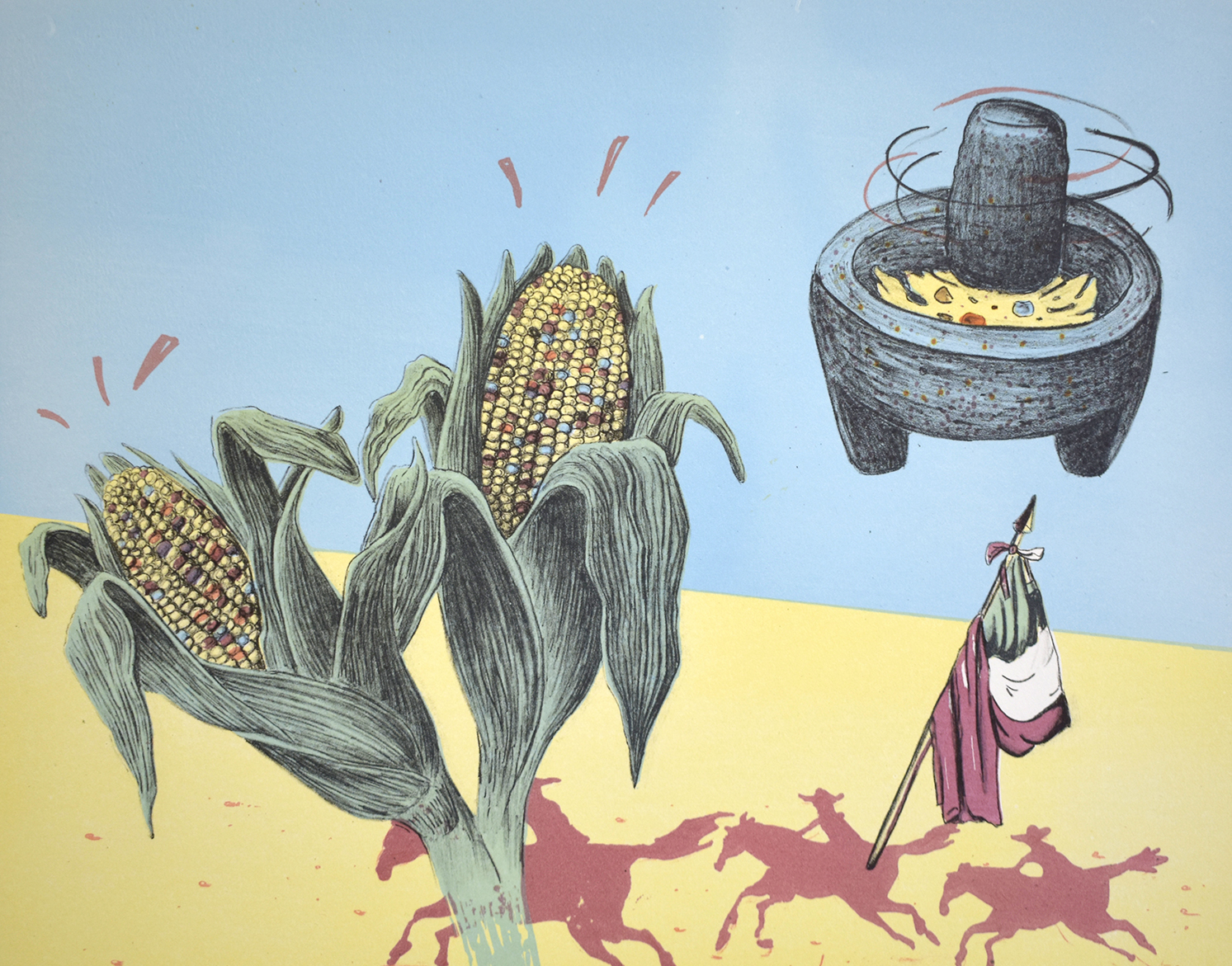
Maiz is Who You Are, Who We Are
Lithograph, 15″ x 20″, 2022
B: Your work is largely about Latinx culture and the migration stories of your family. Do you see your artwork as an expression of a broader mission of advocacy? Have you had to strike a balance between depicting your experience with any expectations or pressure to represent all immigrants and/or the whole Latinx community?
JEH: There is a saying by Marian Wright Edelman, “ You can’t be what you can’t see”. I have found this to be true when I have encountered students, families, and the general public surprised when they can identify a part of themselves within my prints and inter-generational experiences growing up in the U.S. I don’t aim or claim to create work that represents the experience of all immigrants and/or the whole Hispanic community. We cannot assume that an individual artist speaks for an entire community. Our differences are not monolithic.
Getting the Ball Rolling
Many of the opportunities that I have came organically. Some came from constantly applying for shows, grants, residencies, etc but once I started entering into these it became easier. I have always been a “people” person. Even though it’s uncomfortable I tried to meet people in the Albuquerque community, at SGCI, and any event that I attended. I wanted to get to know people first and slowly the ball started to roll.
…
Once opportunities started rolling in…
I had to seek advice on how to get my application materials together, how to make frames, how to pack and ship artwork safely, etc. All this information and knowledge was foreign and some of it I learned and researched on my own. Yet, much of it came from asking other artists and asking for advice. Once I began finding my BIPOC community of artists in grad school and outside of school it all really helped.
B: You are so busy with exhibitions and residencies etc.! How did you find these opportunities, or how were you invited?
JEH: Ever since I began graduate school, I knew that I wanted to teach at a collegiate level. I was given great advice in the beginning of my program to exhibit, focus on studying as much as I can, make as much as I can and be active in sharing your work outside an academic setting. Many of the opportunities that I have came organically. Some came from constantly applying for shows, grants, residencies, etc but once I started entering into these it became easier. I have always been a “people” person. Even though it’s uncomfortable I tried to meet people in the Albuquerque community, at SGCI, and any event that I attended. I wanted to get to know people first and slowly the ball started to roll. However, the artwork always comes first. I make my artwork because it is important for me and I genuinely believe I have a message to share. I suppose folks have started to believe in me as well.
I remember that while I was in graduate school I tried to apply to five opportunities a month if I could. It could be an exhibition, grant, popup show, a workshop, you name it. Anything that may be interesting for me. Four of the five opportunities needed to be free because I couldn’t afford to pay $35 — $50 for each application each month. For the first year and a half of grad school I kept getting rejected but I realized that I wasn’t applying strategically. I was applying to things that sometimes my subject matter didn’t have anything to do with a show. Or sometimes I didn’t meet the requested requirements. Once I realized that and had accumulated all these applications I changed my strategy. By my second year of graduate school my ideas, style, and my concepts became more cohesive and clear. Although it’s a lot of work, it’s important to get the work out there. My show with Humberto Saenz at the Janet Turner Print Museum occurred because I had participated in the group show The Fierce Urgency of Now: Socially Engaged Printmaking and got invited back to do a two person show. The publications I have been a part of in the last few years were because people had seen my work around the country (Print Austin, SGCI, Print Fiesta in Silver City NM). My invitation to Bucknell occurred because Eddy Lopez saw my work at SGCI in Madison. So it has all been very organic and I am thankful for it all.
I had to seek advice on how to get my application materials together, how to make frames, how to pack and ship artwork safely, etc. All this information and knowledge was foreign and some of it I learned and researched on my own. Yet, much of it came from asking other artists and asking for advice. Once I began finding my BIPOC community of artists in grad school and outside of school it all really helped. From time to time, I reached out to my friends Marco Sanchez, or Leigh Garcia, Eddy Lopez, Martin Wannam, Ranran Fan etc for advice and it helps.
I have followed that practice of applying to 5 different opportunities postgraduate school until the past year and I am finally slowing down now to make new work. But I always say that and might apply to a thing or two still…. I might be a workaholic!
In terms of finding places to find opportunities, websites life Cafe, IPCNY resources page, SGCI’s Resource Page, and Instagram have been great places to look. As well as looking up artists and their CV’s and see where they have been or applied to.
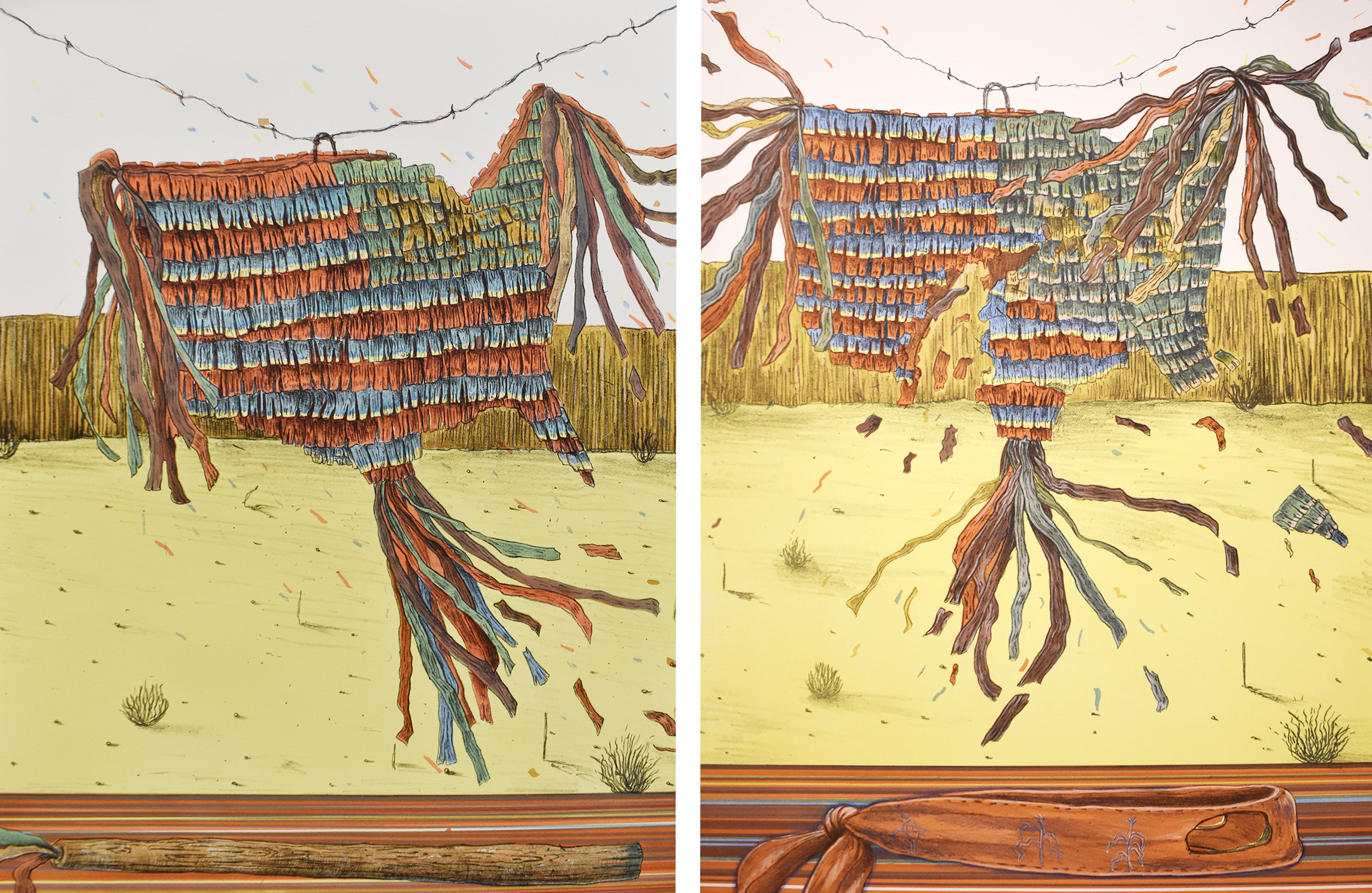
El Jugo Americano 1 & 2
Lithograph, 20″ x 15″, 2023
B: Congratulations on being part of the recent New Voices: On Transformation exhibition at Print Center New York. Can you share about that experience? Has it led to other opportunities?
JEH: Thank you. The IPCNY New Voices Program was an incredible experience where I was able to show my artwork in New York City for the first time. I believe there were about 400 applications and it narrowed down to 8 people. The program had an exhibition component, public programming, cohort community building, an honorarium and a trip to New York City for the exhibition. My mom, sister and oldest niece joined me for the opening of the exhibition. That was really special for my family to see my career taking off. My nieces want to be artists and I hope that I can help them in the future with that dream. As for my mom, it was her first time in NY and coming from a rural town in Mexico it was a dream come true for her. I believe there were about 500 people that attended the opening night.
This program was incredible because it gave me the opportunity to share my work with a community that I hadn’t yet before. The chance to share space and get to know the other artists in the cohort, the folks at the print center and curators was great. I haven’t particularly gotten any opportunities that have stemmed from this yet but it just might.
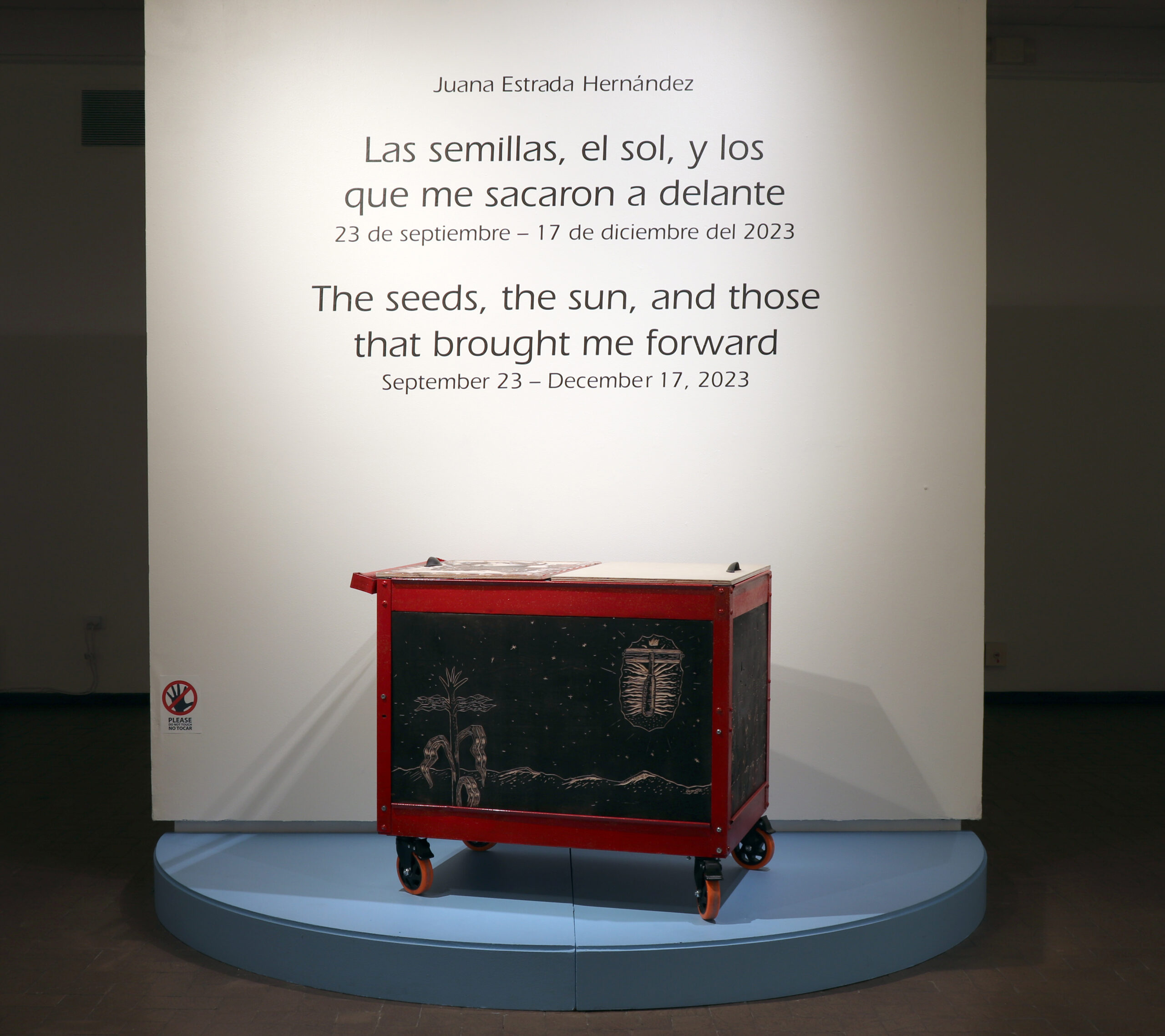
Paleta Cart, installation view
Metal, woodblocks, paletas, foam; 36″ x 24″ x 32″; 2023
Photo credit: Maria “Masha” Beitz, courtesy of the Roswell Museum
B: What are your goals for the next couple years? How have your goals/priorities changed since being out of school?
JEH: My goals for the next couple of years is to start moving towards building a home studio. I recently purchased a tabletop lithography Takach press with the help of my family. While I was in graduate school I purchased a small etching press by selling work. I wanted to ensure that I could keep making prints after school was done. Over the years I have been slowly piecing together what I need to build the studio that I need to make me happy. With my new position at RISD, I need the time to get settled and see what kind of studio I need in my new home.
In terms of artwork I would like to publish some children’s books with the help of my nieces and nephew. Most of my artwork is very illustrative and it feels like a natural next step. I want to learn how to use the Procreate app more efficiently and invite the challenge. It would be another way to make multiples and make my work more accessible. I want to continue expanding on my art practice in new and exciting ways.

Paleta Cart, installation view
Metal, woodblocks, paletas, foam; 36″ x 24″ x 32″; 2023
Photo credit: Maria “Masha” Beitz, courtesy of the Roswell Museum
B: What advice would you give current students as they’re about to journey into the wild? What do you wish you’d been told or prepared for?
JEH:
- Believe in yourself first. You will need to be your biggest advocate.
- Being an artist will be difficult.
- Focus on developing your technical skills in your interested medium(s).
- Make as much work as you can. You need to make bad prints to eventually make good ones.
- Find the ideas, materials, concepts that interest you and take a deep dive.
- Find your artistic community while in school and outside of it.
- Seek advice and help when applying for professional opportunities from your support network of faculty, artists, and friends who have done similar things.
- Get your artwork out there as much as you can~ have a website, an email, images of your work, social media. Just be able to digitally share your work and be accessible to a certain degree.
- Learn to say “No”. Not every opportunity will serve you. This one was the most difficult to learn because when you are starting it feels like everything has to be a”yes”. What are the opportunities that will be the best for your personal goals?
- You need to have or develop some organizational skills.
- Take as many free workshops as you can. (packing your artwork, writing an artist statement, writing a grant, etc).
- Be gentle with yourself.
- Stay curious and keep learning.
- Have patience.
I wish that someone would have told me that being an artist takes work and it will be difficult. I had this illusion that I could make art everyday and somehow everything would work out. What some students (and I back then) didn’t realize is that you are your biggest advocate. I needed to learn that in order to be considered for any opportunities I had to “market” my work and myself. It is difficult to hear that because marketing comes down to money as the bottom line. Yet if we don’t document, share, and make our work accessible it will be difficult to make a living as an artist. There is so much administrative work in the background. That part was the hardest to learn to do because writing has never been my strong suit. I learned that if I had a difficult time writing about anything it’s a good idea to seek help from others. My friend Paloma Barraza was an art historian grad student who I really clicked with and continues to help me from time to time.
It might sound corny, but you truly have to believe in yourself. My parents and family were always supportive of pursuing a higher education but were nervous about my choice of pursuing the arts. Much less printmaking, a medium that they had never heard before. My immigrant parents did not want to hear that their first generation, DACA-mented daughter wanted to pursue being an artist. Mostly because they didn’t realize that this path was possible and worried for my future. I was discouraged from time to time but I never allowed myself to quit on my dream. I had to be patient and believe in the path that I was creating for myself and others.
